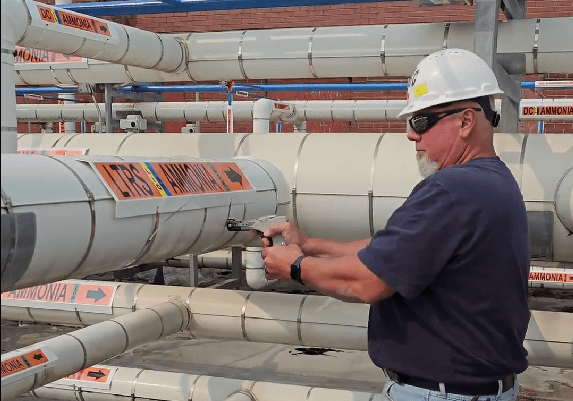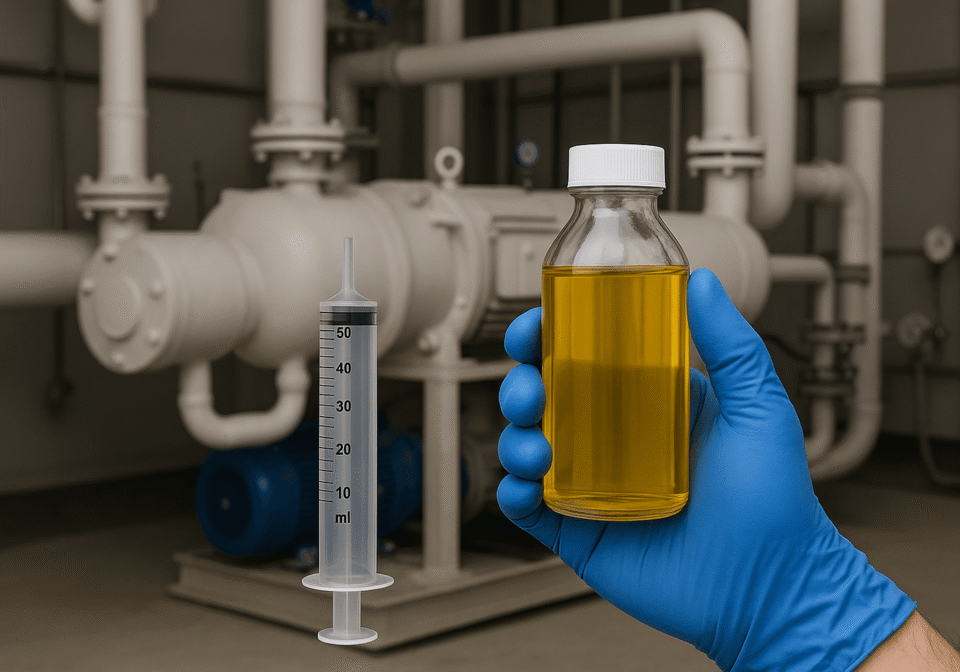Ammonia Refrigeration Systems Pipe and Equipment Labeling
Pipe and equipment labeling is a seemingly mundane task, yet it is critical that it is performed correctly, and that the correct materials are used based on the facility location and environment. If this simple task is not completed or piping and equipment have been labeled incorrectly there can be major consequences. Such as an employee or contractor may cut into the wrong pipe to perform maintenance and experience an unexpected release of ammonia.
Industry Guidelines
IIAR 2 2021 Appendix Q – 1.0 Introduction, has guidelines for the installation of labels for both pipe and equipment. OSHA and EPA respectively may identify this as a deficiency during an Inspection if IIAR 2 is not followed.

Material Types for Labels
The 3 Material Types for labels are:
- Wrap-A-Round Labels
- Carriers with Labels
- Self-Adhesive Labels
Wrap-A-Round Labels, also referred to as Coiled Pipe Markers
Wrap around labels look good and are easy to install, however, we have seen numerous occasions where they cause corrosion under the label. Water and moisture will accumulate between the pipe and the label and in some cases can result in severe corrosion. We have identified such corrosion during a Mechanical Integrity Inspection when the wrap around labels were installed on Non-Insulated Pipe.
The remedy is to have an annual preventative maintenance task to slide the markers down the pipe to a new location. Or consider Non-Destructive Testing to determine pipe remaining thickness or replace pipe depending on the severity of the corrosion.
It is shameful to spend money and time doing the right thing and following the guidelines, to find out later that it caused damage to the integrity of your system’s piping.
The Wrap Around labels can be installed on INSULATED PIPE, and they look great because you can see them from any direction. Be advised that moisture will also accumulate under the wrap-a-round labels on INSULATED PIPE. The after effect will be mildew and possibly mold, while not preferable, won’t damage the integrity of the system.

CARRIERS WITH LABELS
Carriers are the most expensive of all of the materials for labeling, however, they do have several advantages. Carriers can be used on NON-INSULATED AND INSULATED Pipe, plus they can be re-used during an insulation project, and have the most durability.
The initial investment for Carriers is steep, however, they could save you money in the long term. For example, if the label itself starts to fade, you can apply a new Self-Adhesive label and reuse the carrier.
Carriers take longer to install, and making sure the metal bands are tightened properly will prevent them from coming off during storms or high winds. Please note, you must have the right tools to install the carriers properly.
Self-Adhesive Labels
The most common labels we see used during Mechanical Integrity Inspections are the Self-Adhesive Labels. They are by far the most affordable way to label pipe and equipment. The application for the Self-Adhesive Labels can be used on NEW PIPE and EQUIPMENT. The chances are good for the adhesive to adhere to the pipe and equipment. However, if the plant is dated, the pipe is corroded, paint is chipping, or the insulation is dirty and has mold/mildew, the Self-Adhesive Labels will not stick, and can often be found on the ground or on the roof top within a few weeks of the application. Also, if a production area has moisture in the air, such as water or steam, the Self-Adhesive Label will not stick.
In areas where NON-INSULATED PIPE has a good paint coating, we can brush and clean the surface before applying the self-adhesive label which will offer some cost savings to the plant. However, it is not an ideal situation for making sure the labels stay intact in the long term. Self-Adhesive Labels should be designed to adhere to all temperature ranges in the refrigeration system and have UV Protection for areas that are on the roof or located outside.

Real World Application
Bottom line, it is IMPERATIVE to make sure the labels that are purchased, are applied correctly, and are inspected regularly, no matter which type you choose.
Like most contractors, we learn from experience. We recently completed a labeling project for two separate facilities. A year after completion, we realized we were supplied labels without UV protection, and the labels were fading and illegible. We corrected our mistake, reordered the labels with UV Protections, and did the job over at our expense to ensure the project was done correctly. While we don’t like to highlight our mistakes, it’s important that we hold ourselves accountable to the highest standards and will go above and beyond to correct them and ensure that we have procedures in place so this does not happen again. Some lessons are hard to learn, but once we learn them, we never forget them.

Wrap Up
Labeling is a simple, yet vital task for compliance at your facility, and needs to be done correctly using the IIAR guidelines.
If you are currently weighing your options for a labeling project here is a tip: Ask the Contractor to quote the project as follows:
- Carriers for Pipe 8” or larger (Headers)
- Wrap A Rounds for Insulated Pipe
- Carriers for Non-Insulated Pipe where a Self-Adhesive Label will not stick.
- Adhesive Stickers for pipe with good paint coatings
- And UV Protection Labels for Roof and Outside Areas or just ask for all labels to have UV Protection.
Remember, you will get what you pay for, so make sure you have it done correctly the first time around.


